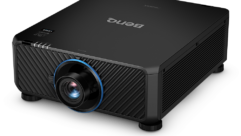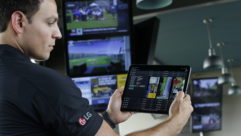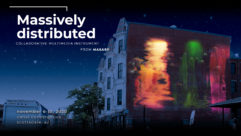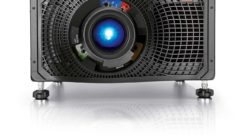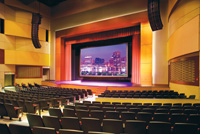

Large-venue Display Systems
Feb 16, 2010 12:00 PM,
By Trevor Boyer
The Draper StageScreen in use with a Panasonic PT-DW7000U-K projector at the Montgomery Peforming Arts Centre.
As the size of a venue or the amount of ambient light in a venue increases, so does the demand for ANSI lumens, the accepted measure of projector brightness. It’s exceedingly simple: A bigger room demands a projector with a more powerful light engine. Unfortunately, there’s not a linear increase in the price of a projector as its brightness notches upward. As you go up, each additional jump requires a bigger investment. There’s a supply and demand explanation: the brighter the projector model, the fewer units manufactured. For this article, we’ve defined large-venue projectors as those models rated at 6000 ANSI lumens or greater.
But the good news is that the manufacturers are saying that sales of their high-brightness models are staying strong in an extremely tough economic environment. That’s probably because even though large-venue models remain expensive relative to less-bright choices, the entire projector market has enjoyed a precipitous drop in prices over the past decade. As usual, we have technological progress and fierce competition to thank for that.
“While the basic physics behind producing light from a light source and putting it on a display device is still the same, the efficiencies, power levels, and display device capabilities have steadily improved,” says George Tsintzouras, director of product management for business products at Christie Digital Systems. He says that a projector that could output 10,000 lumens five years ago would weigh at least 120lbs. Now, Christie offers a 55lb. projector that puts out 11,500 lumens.
Rob Manfredo of Sony charts the progress of projector energy efficiency. “Several years ago, it would have taken a 200W lamp to get 2000 lumens on the screen,” he says. “Now the same size lamp can produce nearly 4000 lumens on screen. This has been achieved by improving optical components in the light engines, especially the imagers.”
This article surveys the choices available to systems integrators who need to specify a large-venue projector. Of course, a projection screen stands (or hangs) at the end of any projected video signal chain. With that in mind, we share the perspectives of several manufacturers of projection screens: How big do their big screens get, and what types of screen materials are buyers of large-venue projectors selecting?
Large-venue Display Systems
Feb 16, 2010 12:00 PM,
By Trevor Boyer
The Large-venue Projector Market

Barco RLM-W6
Late last year, Barco debuted the RLM-W6, a 3-chip DLP projector that the company describes as “the world’s first 3-chip DLP projector that comes with a single-chip DLP price tag.” (Pricing information was not available at press time.) It’s a 6000-lumen model, so it occupies the lower tier of the company’s high-brightness space. Barco notes that the WUXGA-resolution (1920×1200) RLM-W6 consumes 33 percent less power than comparable projectors and is considerably quieter. Barco’s free Projector Toolset software, which manages multiple Barco projectors across a network, is compatible with the RLM-W6.
If performance outshines cost considerations for a large-venue projector, Barco offers its XLM HD30 projector, the company’s brightest model, with a light output of 30,000 center lumens thanks to its 6.3kW Xenon lamp. With a native widescreen aspect ratio and native 2048×1080 resolution, the XLM HD30 features a sealed DMD engine and a high contrast ratio (at least 1600:1). Built to work around the clock, the XLM HD30 projector is a sturdy single-box/cabinet projector.
Barco also offers the CLM HD8, a cost-effective, compact 8000-lumen DLP projector with full HD (1920×1080) resolution. It’s priced in the same range as high-brightness LCD projectors.
With its dual-lamp configuration, the BenQ SP920P outputs 6000 lumens and claims a 2000:1 contrast ratio. The SP920P uses Coolux’s morphing software for projecting large, complex public displays such as 360-degree domes, spheres, and unconventional forms. It is available from BenQ at one-third the previous cost of a projector with such capability, according to the company. BenQ claims its SP920P exemplifies the way innovative engineering can keep projection possibilities looking great while staying affordable.

Boxlight Pro80S3
Boxlight‘s brightest projector, the Pro80S3, is an 8000-lumen 3-DLP projector. The model incorporates Cinema Color and Cinema Contrast, proprietary motion picture looks that produce brilliant colors, pleasing flesh tones, and rich contrast. Boxlight offers up to a six-year warranty on projectors and three years on lamps. A three-year projector/90-day lamp warranty comes standard with any model.
The Canon Realis LV-7585 multimedia projector has its lens positioned in the center for ease of placement during ceiling-mount installation. The LV-7585 relies on liquid crystal on silicon (LCoS) technology to produce 6500 ANSI lumens of brightness. The model features a side-loading, easy-access replacement lamp and an autowinding filter system, which automatically winds forward to expose a new, clean section of filter. The LV-7585 offers the flexibility of using its standard 1.3X Canon Optics zoom lens with power lens shift (horizontal and vertical) or any of four optional interchangeable Canon lenses. The optional LV-NI02 network imager enables users to send presentations to the LV-7585 via the network while enabling a variety of network control, monitoring, and image-projection functions.
Large-venue Display Systems
Feb 16, 2010 12:00 PM,
By Trevor Boyer
Last fall Christie Digital Systems introduced its brightest projector, the Roadie HD+35K, a 3-DLP, 2048×1080 model that puts out 32,500 ANSI lumens. The projector has a split-body design with a separate switching-lamp ballast. The Roadie HD+35K includes a rear air-exhaust hood for improved stacking.
The Christie Digital Systems M Series now includes four resolutions: WXGA (1366×768), SX+ (1400×1050), HD (1920×1080), and WUXGA (1920×1200)—all with a variable contrast ratio of 2500:1 to 10,000:1. A prime example of the Christie M Series, the HD10K-M, is a dual-mercury-lamp, 3-chip DLP projector rated at 10,000 lumens, with features such as warping, blending, and tiled array as standard.
Related Links

The market for what once was called “large venue projectors” is rapidly changing as the technology evolves, prices come down, and large flatpanel displays are increasingly considered competitors….

Technology Showcase: Home Theater Projectors
If you want to get the big picture, nothing beats a projector. Home theater projection systems are proving to be one of the most innovative market segments of the domestic entertainment business….

Technology Showcase: Corporate Projectors
The projectors being used in corporations today reflect the realities facing our society. They are being squeezed by cost-conscious purchasers, improved by vibrant competition, wrestling with requirements meant to keep our environment clean, and generally improving in quality every year…
Christie claims that its brightest, most cost-efficient 3LCD large-venue projector, the Christie LX1500, is the world’s brightest projector in its class, delivering 15,000 lumens via a four-lamp, 3LCD optical engine. The LX1500 combines native XGA resolution and 2000:1 contrast ratio with the latest 10-bit image processing. The LX1500 is a body-only format projector; 11 lenses are available with throw ratios from 0.8:1 to 9.0:1.
The new Lightning 45-1080p (30,000 ANSI lumens and 2000:1 contrast ratio) projector from Digital Projection International (DPI) includes DPI’s Intelligent Lens Memory (ILM) feature, which allows the projector to store specific lens zoom, shift, and focus values to up to 10 preset positions. The Lightning 45-1080p incorporates DPI’s CoolTek engineering, which ensures the projector delivers high-lumen performance with low power consumption and thermal and noise output.
In addition to its 3-chip 3D offerings, DPI is offering two active 3D projectors in its single-chip projector lineup: the iVision sx+ 3D, which is equipped with a standard zoom lens, and the iVision sx+ W-3D, which is equipped with a short-throw fixed lens. At the 3-chip level, DPI’s new Titan 3D product range is composed of eight distinct projectors (including the Titan 1080p Dual 3D) featuring Texas Instruments’ 3-chip DLP technology with fast-transit pixels for smooth grayscale and improved contrast. The Titan 3D product line offers brightnesses up to 9000 ANSI lumens and contrast ratios up to 5000:1. For active 3D applications demanding the highest lumen performance, DPI’s new Lightning 3D offers the same source compatibility and imaging capabilities as the Titans while producing up to 21,000 ANSI lumens and 4000:1 contrast.
The Dukane ImagePro 8950P large-venue LCD projector uses three 1.3in. polysilicon inorganic TFTs, puts out 7500 lumens through selectable lenses, and features networkable control capabilities. With a 2500:1 contrast ratio, 10-bit full digital video processing, and a filter life of 10,000 hours, the 8950P gives you XGA resolution (1024×768), ultrawide-range lens shift (2.7 screens vertical and 2.2 screens horizontal), and six bayonet-style lens options.
In addition, Dukane’s ImagePro 8952P is a 7000-lumen model with long-life inorganic LCD optics, a mechanical shutter for Blank mode, SXGA (1400×1080) resolution, versatile connectivity, and powered lens shift and powered focusing. Finally, the company’s ImagePro 8951P brings most of the same features with a 6500 lumens output.
Large-venue Display Systems
Feb 16, 2010 12:00 PM,
By Trevor Boyer
During CES, Epson introduced its brightest large-venue projector model to date. The PowerLite Pro Z8050WNL offers 7000 ANSI lumens, a step above its cousin the Z8000WUNL, which offers 6000 lumens. If resolution is more important to you than brightness, however, the older Z8000WUNL (1920×1200 native resolution) trumps the newer model (1280×800). Both models offer 5000:1 contrast ratios, dual lamps, and are liquid-cooled. Six different lenses are available, including a rear-projection option. According to Epson, the two 3LCD projectors can be installed up to 30 degrees off-axis horizontally and 10 degrees off-axis vertically.
The LCD panels and polarizers in the Hitachi CP-SX12000 (1400×1050 resolution) output 7000 lumens and are made of inorganic, UV-resistant materials, resulting in a longer operating life, the company says. The Projector Management Application (PJMan) loaded in the CP-SX12000 allows users to monitor and control multiple projectors over a LAN. A network bridge (serial pass-through) allows users to send RS-232 commands to the projector via the Ethernet commands pass-through, enabling control of external devices such as TV tuners and visual presenters.
Hitachi also offers the CP-WX11000, a large-venue projector that provides 6500 lumens and WXGA resolution (1366×800). Its aspect ratio of 17:10 matches that of today’s most popular widescreen laptops. The CP-WX11000’s 2500:1 contrast ratio and mechanical iris are controlled automatically to ensure the ideal image contrast and depth perspective during both bright and dark scenes.
If more brightness is needed, stacking is an option. According to John Glad, a product manager with Hitachi, the wide lens shift common to the company’s projectors makes them suitable for stacking. “With our lens shift,” he says, “we can either stack or put side by side and achieve the same results.”
The InFocus IN5534 large-venue projector features DLP DarkChip liquid-cooled DMD technology with InFocus’ own implementation of BrilliantColor. The projector has a brightness of 7000 lumens, WUXGA (1920×1200) resolution, and motorized lens adjustments for flexibility during installation. InFocus touts the IN5534’s legacy analog inputs as well as its comprehensive digital connectivity. Embedded wired and wireless DisplayLink ensures hassle-free plug-and-project connectivity over USB. Moreover, PC-free playback is possible via a standard USB stick with the InFocus LitePort.
The Mitsubishi XL6500U shines at 5000 lumens in XGA (1024×768) resolution using three 1.3in. inorganic LCD panels. The projector’s lamp is rated at 4000 hours when operated in lamp life-conserving Low mode. The XL6500U offers electronically controlled zoom, focus, and lens-shift adjustments in fast and step modes.
Last August, NEC released its NP4100W projector, a WXGA wide-aspect-ratio DLP design rated at 5500 ANSI lumens. Five optional bayonet-style lenses are available. The NP4100W’s Eco mode decreases fan noise and increases lamp life by up to 50 percent for a 3000-hour lamp life. Quick Power Off technology protects the lamp during cool down. A sealed, dust-resistant optical system enables better picture quality and reduces maintenance. An optional six-segment color wheel is available on the NP4100W for applications requiring especially rich color saturation. The NP4100W can function as either a dual- or single-lamp projector.
Slightly less bright than the NP4100W are NEC’s stackable 3LCD projectors. Put two together, however, and you’re well over 7000 lumens at the low end. The NP3250, NP3250W, NP2250 and NP1250 offer brightness ratings of 5000, 4000, 4200, and 3700 lumens respectively. NEC uses a camera and software system to align the stackable projectors’ images. “This system allows all convergence data to be stored on the projectors,” says Rich McPherson of NEC, “which means no matter what source you connect to the projectors, it will be bright and converged. Other systems require external hardware to do this.”
Large-venue Display Systems
Feb 16, 2010 12:00 PM,
By Trevor Boyer
The Panasonic PT-D6000US takes single-chip DLP projection to a high brightness level of 6500 lumens and claims new levels of color reproduction (up to 145 percent of conventional models) with the aid of the newly engineered RGB Booster, Panasonic’s proprietary Vivid Color Control technology, and a newly engineered lamp modulation drive system. Image-processing circuits in the PT-D6000US analyze the video signal frequency range for each scene by extracting data on the distribution of high-, mid-, and low-frequency components, and they bring out fine details accordingly. Maintenance is simplified by the PT-D6000US’s autocleaning filter, which makes filter cleaning unnecessary for about 10,000 hours.
Norway’s projectiondesign offers its first 3-chip DLP projector, the F80, with 8000 ANSI lumens of brightness and a contrast ratio of up to 10,000:1. That rating is thanks to contrast-enhancement technologies that are unique to projectiondesign and a first for 3-chip DLP projectors, according to the company. Key features in the F80 include infinitely adjustable iris and aperture settings and motorized zoom, focus, and shift with memory for use in multiple settings with programmed calibration. The projector combines fixed and motorized optical filters for each color channel. Every lens for the F80 uses low-dispersion (LD) aspherical glass elements for high-quality focusing and sharpness, as well as high optical interfield contrast, resulting in very high perceived image quality.

projectiondesign F35
Late last year projectiondesign added to its line the F35, a WQXGA-resolution (2560×1600) 6500-lumen model. “We have significantly raised the bar when it comes to number of pixels,” says projectiondesign’s Chris Axford, “though this comes without an increase in the imager (DMD) size. We are of course working closely with TI to secure the next step in resolution, but nothing is finalized as yet.” Projectiondesign says that the F35 WQXGA platform will come with a new range of projection lenses to optimize the output of the higher-resolution chipset.
Last December, the company also introduced a new blend/warp hardware product known as MIPS. Looking toward the future, projectiondesign is developing an LED light engine for its large-venue models. (At CEDIA this year, the company introduced an LED-lit single-DLP model.) LED promises purer color transmission and a significant leap in energy efficiency.
Sanyo says its PDG-DET100L, rated at 7500 lumens with an SXGA resolution (1400×1050), is the brightest DLP projector in its class. The single-chip PDG-DET100L is outfitted with two 330W VIDI UHP lamps, contributing to its increased light output efficiency. To achieve high brightness and rich color reproduction, it is equipped with Sanyo’s user-changeable color wheel system. Six optional lenses are available.
Large-venue Display Systems
Feb 16, 2010 12:00 PM,
By Trevor Boyer

Sharp XG-P560W
With the introduction of Texas Instruments’ 0.65in. WXGA DLP chip and 0.7in. XGA DLP chip, Sharp has been able to introduce what is considered a price-performance breakthrough in 3-chip DLP projection. The Sharp XG-P560W (5200 ANSI lumens, WXGA native resolution) and XG-P610X (6000 ANSI lumens, XGA native resolution) are priced at less than $15,000, including a standard motorized lens with horizontal and vertical lens shift. Several Sharp large-venue projectors (including the XG-P610X, XG-P560W and XG-PH70X) use an intelligent dual-lamp design in addition to offering two brightness modes (Full Brightness and Eco+Quiet). Dual lamps offer a brightness boost as well as redundancy: In the event that one of the lamps fails during the show, the second lamp continues to operate.
At the extreme high end, Sony employs silicon-crystal reflective technology in its SXRD line of projectors. The SRX-T420 model’s 21,000 lumens of brightness and 4K resolution (4096×2160) makes it appropriate for visualization, planetariums, dome theaters, and more. Sony actually manufactures the SXRD line’s imagers, as it does for its HTPS LCD models.
Aimed at more mainstream applications, the 3LCD VPL-FH300L projector is Sony’s first fixed-installation business projector featuring 2Kx1K resolution (2048×1080). The installation flexibility of Sony’s VPL-FH300L is enhanced with five lens options and the ability to tilt the projector freely on the vertical axis. This projector features a two-lamp system that uses two low-wattage lamps (275W) in an opposed layout to produce 6000 lumens.
Last year, ViewSonic launched its brightest projector, the 5000-lumen PJ1173, with a 1024×768 native resolution and a 1000:1 contrast ratio. The PJ1173 features manual zoom, horizontal and vertical keystone correction, and a remote with mouse control and laser pointer. The projector also includes features such as progressive scan and video noise reduction for smooth motion performance when viewing video or any kind of animation.
Large-venue Display Systems
Feb 16, 2010 12:00 PM,
By Trevor Boyer
Screens
Most manufacturers of projection screens are seeing increased demand for larger screen sizes. This suggests that for many markets, the drop in high-end projector prices trumps the current economic recession.
In response to increased demand, Da-Lite added a Design Center module to its website, which focuses on large-venue screen design. “We are seeing a lot more requests for large screens and unique screens,” says Wendy Long of Da-Lite. “We have made large screens that are curved, cylindrical, star-shaped, dome-shaped, and all sorts of others.”
Manfred Freiberger of dnp has a similar view. “Dnp sees a general trend toward larger screens for almost all segments and for all applications,” he says. “The main driver for that is that large-venue projectors are becoming more affordable.”
Long says that 16’x9′ is a pretty typical size to couple with a large-venue projector that offers 8000 lumens of brightness. (Other manufacturers cite similar sizes.) For super-bright projectors and edge-blended projector systems, Da-Lite can go up to 39ft. wide for an electric screen or 90ft. for a fixed-frame screen.

Da-Lite Series 300
The latest addition to Da-Lite‘s extensive line of motorized projection screens is Studio Electrol. With an extruded aluminum case, a gray finish, and screen sizes up to 32ft. wide, the Studio Electrol is well-suited for large-screen applications.
Danish manufacturer dnp says that with large-venue projectors, it typically matches its Supernova Infinity screen, a custom model. Its Supernova One, Supernova Core, and (soon) its Supernova Flex get as large as 120in. on a 16:9 diagonal; the Supernova Infinity is for larger screens. “It is a building-block screen that consists of screen panels that can be tiled to any size,” Freiberger says. “There is literally no size limitation—at least we haven’t found it yet.”
The Supernova line is a high-gain line that uses optical, rather than chemical, filters to enhance a projector’s perceived brightness. These filters reject ambient light and reflect only the light from the projector. Among seven filter layers, the most significant is the vertical light-rejecting filter. Two screen materials are available; according to dnp, customers buying larger screens often prefer the better viewing angles of Supernova 08-85 material over the better brightness of Supernova 20-20.
Large-venue Display Systems
Feb 16, 2010 12:00 PM,
By Trevor Boyer
Draper‘s new StageScreen for fixed and portable applications can be as large as 60’x18′. The company also goes up to 24ft. wide with its new Paragon/Series V motorized screen with tab tensioning, and 28ft. wide with the Paragon/Series E motorized screen (with a textile-backed viewing surface). According to the company, Draper offers custom sizes up to 80’x30′ in a fixed screen and motorized screens up to 28ft. wide. For front projection, Draper says that the most popular surface remains a basic white product, either the M1300 or Flexible Matte White. “Large applications may use multiple projectors across a single screen where brightness uniformity, blending, or edge-matching are important factors to address,” Draper’s Jim Hoodlebrink says. “This is why the uniform Matte White material is used.” This increased demand in large venues has also spurred Draper to introduce a new low-gain, flexible rear-projection material that allows for improved uniformity in applications where multiple projectors are being used.
Elite Screens makes its VMAX Plus4 electric projection screens with seamless material up to 380in. (on the 16:9 diagonal) and stocks available product up to 400in. for immediate shipment. Elite’s fixed-frame screens are available up to 206in. diagonal. Like Draper, Elite says that Matte White is the most common surface for big screens. “They are generally used with a more powerful projector,” Elite’s David Rodgers says. “There is light control in conference halls, and [matte-white material] has uniform diffusion to present a well-lit image to the eyes of the audience regardless of whether they are directly in front of the presentation or off to the side.” For environments with higher ambient light, such as houses of worship, ultrahigh-gain material (such as Elite’s Starbright7) with contrast filtering is popular. The material creates a narrow half-gain cone that looks great at a distance, Rodgers says.
Vutec offers a wide range of projection screens that are appropriate matches for large-venue projectors. At InfoComm 2009, the company introduced Fusion-HD, which can be designed to fit any application with a preassembled frame or can be suspended from any ceiling structure. The acrylic screen line has a 180-degree viewing angle and rejects a high percentage of ambient light. Vutec also offers a fixed-screen choice called SilverStar, which the company claims offers six times the brightness of comparable screens. Its Lectric II and Vision XTC retractable motorized in-ceiling mounted screens disappear into the ceiling or wall for dust-free storage with the touch of a button.


